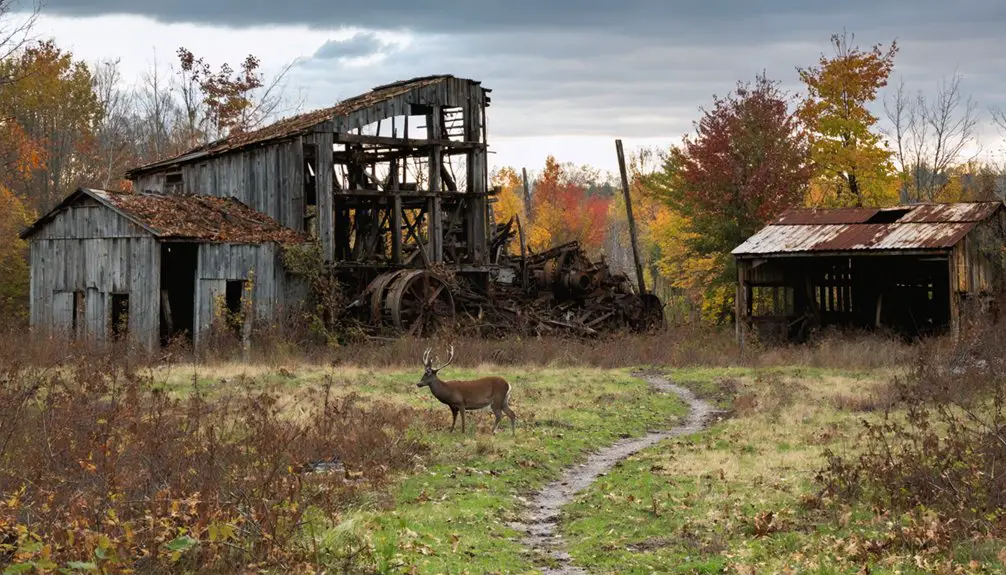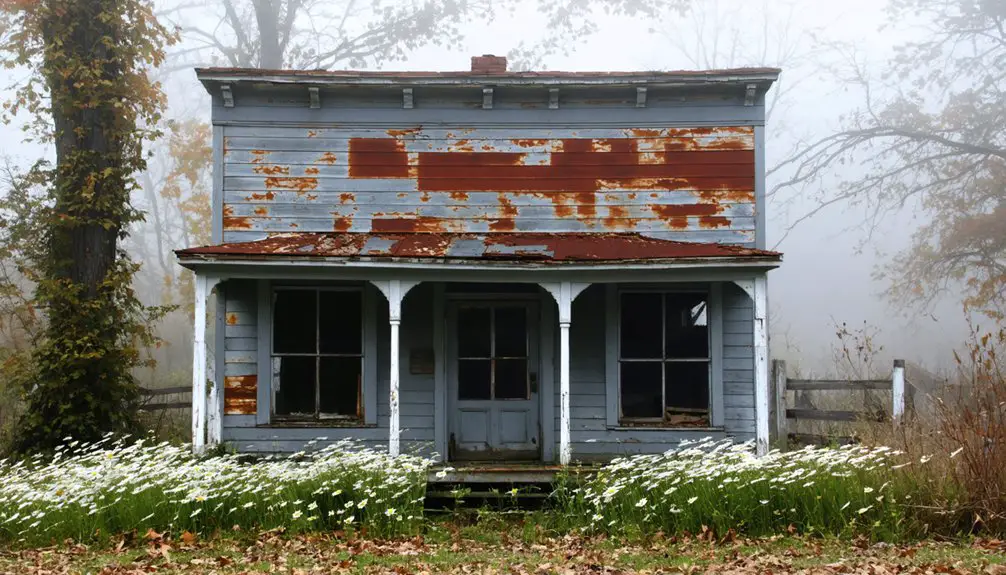You’ll discover Colonville thrived as a lumber boomtown in Michigan’s Thumb region during the mid-1800s, strategically positioned near dense forests and crucial waterways. The town’s fortunes rose with multiple sawmills and the arrival of the Detroit and Bay City Railroad in 1872. Despite its promising start, Colonville couldn’t sustain itself once timber resources depleted. The abandoned settlement’s story mirrors countless Michigan lumber towns that rose and fell with America’s great logging era.
Key Takeaways
- Colonville was a thriving 19th-century lumber town in Michigan’s Thumb region that relied heavily on timber production and sawmill operations.
- The town’s strategic railroad connections included the Detroit and Bay City Railroad (1872) and Grand Rapids & Indiana Railroad (1890).
- Economic decline began when timber resources were depleted, leading to the closure of sawmills and exodus of workers.
- The post office’s closure in 1956 marked a final turning point, significantly reducing the town’s connectivity and essential services.
- Environmental impacts from deforestation, limited economic diversification, and isolation ultimately led to Colonville becoming a ghost town.
Early Settlement and Origins
During Michigan’s mid-19th century expansion into its resource-rich Thumb region, Colonville emerged as one of many frontier settlements focused on the area’s abundant timber resources.
You’ll find its origins deeply rooted in the strategic placement near dense forests and essential waterways, which early settlers recognized as critical for transporting lumber to market.
The town’s first inhabitants included a mix of determined loggers, entrepreneurs, and families who saw opportunity in the vast stands of Michigan timber. Similar to Port Crescent which had two steam-powered sawmills, the settlement rapidly developed industrial capacity to process the surrounding forests.
Like many settlements that would become ghost towns later, Colonville’s prosperity was entirely dependent on its natural resources.
They established primitive sawmills and supporting businesses, creating a bustling frontier economy.
While these early settlers initially built basic wooden structures and rough roads, they quickly developed the fundamental community infrastructure you’d expect in a growing lumber town – including general stores, blacksmith shops, and eventually churches and schools.
The Boom Years (1850-1890)
The rapid rise of Colonville’s lumber industry in the 1850s transformed this Michigan settlement, as you’d find multiple sawmills harnessing local water power to process the region’s abundant timber resources.
The Erie Canal opening in 1825 enabled more efficient transportation of lumber and goods to eastern markets.
A strategically placed railroad station, established during Michigan’s rail expansion, connected these mills to major markets and brought waves of settlers from New York and New England states.
Like other Michigan settlements that emerged after British troops withdrew in 1796, Colonville grew steadily as more pioneers ventured westward.
Early Lumber Mill Operations
As Michigan’s virgin forests beckoned in the 1850s, lumber companies rapidly established remote camps deep within the wilderness, transforming isolated outposts into bustling centers of production.
You’d find a diverse workforce of immigrants from Ireland, Sweden, Norway, and Finland working alongside Americans from New England, all living in camps equipped with cook shanties, bunkhouses, and company stores. Typical crews included two experienced foremen who supervised around seventy men.
Early lumber production relied heavily on water-powered mills, but the shift to steam power in the 1860s revolutionized operations. The spring rains enabled loggers to guide their timber in a process known as booming downstream.
You could see massive technological improvements as crosscut saws replaced axes, and Cypress Overpack’s eleven-foot “Big Wheels” enabled year-round logging.
These innovations, combined with new logging techniques like ice road transport and river drives marked with company symbols, turned Michigan into America’s leading lumber producer by the late 1880s.
Railroad Station Development
Rail service transformed Colonville’s fortunes in 1872 when the Detroit and Bay City Railroad extended its northern line through the area. Under Cornelius Vanderbilt’s Michigan Central Railroad, you’d have found Colonville connected to Detroit and the broader New York Central system, revolutionizing transportation impact throughout the region.
The railroad architecture showcased the town’s prosperity through its stunning Romanesque-style brick depot, built around 1893. Designed by renowned firm Shelpley, Rutan and Coolidge, the same architects behind Boston’s South Station, the building featured modern amenities for passengers, freight handling, and telegraph communications. Similar to other towns of the era, wooden construction predominated throughout the surrounding region.
The well-maintained depot became your central hub for commerce and social activity, while freight service opened crucial market access for local timber and agricultural products. The station’s development marked Colonville’s peak during the boom years. The town’s original name stems from early settlers who came from Columbia County, New York.
Growing Population Trends
While railroad development spurred Colonville’s connectivity, population trends between 1850-1890 painted an even broader picture of Michigan’s extraordinary growth.
You’d have witnessed a remarkable population migration as Michigan’s numbers doubled from 397,000 to 749,000 in just the 1850s, then doubled again by 1880 to over 1.4 million residents.
The demographic changes transformed the region as settlers from New York, Ohio, and Pennsylvania joined European immigrants, particularly Germans, English, and Irish. They came seeking opportunities in lumber, farming, and trades.
The Saginaw Valley region exemplified this population explosion, with 270,000 new residents arriving between 1860-1890 drawn by the booming lumber industry.
While southern Michigan remained the most populous area, you’d have seen settlement patterns expand northward into central regions like Colonville. This expansion was made possible after the forced removal of Native nations in the 1830s and 1840s cleared land for White settlers.
Economic Foundations and Industry
Like many Michigan frontier settlements, Colonville built its economic foundation on the abundant forests that surrounded the town.
You’d find sawmills driving the local economy, transforming timber into valuable lumber products. However, the town’s limited economic diversification and poor resource management ultimately spelled trouble for its future.
Despite the sawmills’ success in lumber production, Colonville’s fate was sealed by its narrow economic focus and unsustainable forestry practices.
While farming supplemented the logging industry, it remained mostly subsistence-based rather than commercially viable.
The town’s prosperity hinged on its transportation links for moving timber and agricultural goods, but when those routes changed and timber resources dwindled, Colonville’s economic base crumbled.
Unlike other Michigan ghost towns that developed mining or industrial alternatives, Colonville never expanded beyond its initial resource extraction focus, making it vulnerable to the inevitable decline when the forests could no longer sustain the community.
Life in Historic Colonville

If you’d visited Colonville during its peak years, you’d have found a bustling community where pioneer families split their time between farming their land and working in local timber or mining operations.
The general store served as both a supply hub and social center, where residents gathered to exchange news while purchasing essential goods like flour, sugar, and tools.
Local businesses included blacksmiths, boarding houses, and small craftsmen who provided crucial services to support the resource-based economy of the area.
Daily Pioneer Activities
Pioneer life in Colonville revolved around a tight-knit social structure where education, religion, and industry shaped daily activities. You’d find families gathering at local churches and pioneer gatherings, where Episcopalian and Presbyterian congregations served as fundamental social hubs.
The one-room schoolhouse provided communal education, bringing children together to learn both academics and practical frontier skills.
Your daily routine would’ve centered on crucial tasks like visiting the gristmill to grind wheat, preserving seasonal foods, and participating in community hunts.
The local blacksmith shop buzzed with activity as settlers needed tools repaired and equipment crafted. Multi-generational families worked together, with children learning important survival skills alongside their formal education.
Well-worn stagecoach trails connected you to neighboring settlements, facilitating trade and communication across Michigan’s developing frontier.
Local Business Operations
During Colonville’s peak years, local businesses thrived through a diverse mix of manufacturing and retail operations that served the growing pioneer settlement.
You’d find essential sawmills and grist mills processing timber and grain, while specialized craftsmen worked in cooper shops and stove factories. Local commerce centered around general stores and dry goods establishments, where you could purchase everything from tools to textiles.
The town’s business diversity included wagon makers producing crucial transportation equipment, while multiple saloons served as both social hubs and informal trading centers.
Without railroad access, however, Colonville’s merchants struggled to compete in wider markets. By the 1880s, limited transportation options had begun choking the town’s economic lifeline, leading many businesses to close as residents sought opportunities elsewhere.
Transportation Routes and Access
While many Michigan ghost towns faded quietly into history, Colonville’s transportation story reveals how critical access routes shaped both its rise and decline.
Like countless other Michigan ghost towns, Colonville’s destiny hinged on the ebb and flow of its vital transportation arteries.
You’ll find its transportation evolution centered on the Grand Rapids & Indiana Railroad‘s arrival in 1890, which initially fueled the town’s logging industry and commerce.
As timber resources depleted, you’d have witnessed dramatic changes – homes being moved 10 miles to Cadillac and desperate Depression-era scavenging of rail infrastructure for scrap metal.
The town’s access challenges mounted when road networks shifted and bypassed Colonville, while the 1956 post office closure dealt a final blow to its connectivity.
Rail dominance gave way to limited road access, leaving the once-bustling town increasingly isolated until its eventual abandonment.
Natural Resources and Development

Natural resources shaped Colonville’s dramatic rise and ultimate demise, with copper mining leading the town’s early prosperity.
You’ll find evidence of extensive resource extraction in the region’s volcanic rock formations, where high-quality native copper deposits attracted waves of immigrant workers to the Cliff Mine between 1845 and 1854. The surrounding forests provided essential timber for mining operations and spawned additional industries like wagon making and charcoal production.
The town’s residents adapted to frontier life by planting fruit trees in their backyards, creating small orchards that sustained the mining community.
However, the environmental impacts of deforestation and mining eventually took their toll. As copper veins were depleted and timber resources dwindled, Colonville’s economy collapsed, leading to its abandonment when extraction costs exceeded returns.
The Path to Abandonment
Several factors converged to seal Colonville’s fate as a ghost town in the decades following the Civil War.
You’ll find the town’s decline closely tied to its inability to secure crucial railroad connections, which left it isolated from major trade routes. Without rail access, businesses couldn’t compete with better-connected communities, leading to widespread closures of sawmills and wagon makers.
Communities without railroad access often withered as businesses failed to compete with well-connected towns, forcing widespread closures.
The town faced mounting social challenges as younger residents moved away seeking better opportunities, while those who remained struggled with limited access to healthcare and services.
Environmental impacts further hastened Colonville’s abandonment, as natural disasters and resource depletion made economic recovery impossible.
Like many similar communities of its era, Colonville couldn’t adapt to changing transportation patterns and economic realities, ultimately succumbing to the forces that transformed it into a ghost town.
What Remains Today
When you visit Colonville today, you’ll find few traces of the once-bustling Michigan settlement. Nature has reclaimed most of the ghost town, with vegetation covering the scattered building foundations and remnants of former pathways.
While no major structures remain standing, you might discover historical artifacts like tools or household items that occasionally surface from the soil.
The site now exists primarily as private or undeveloped land, with no formal tourism infrastructure or preserved buildings to explore. Local museums hold some artifacts that help tell Colonville’s story, but on the ground, you’ll need to rely on historical maps and records to identify the town’s original location.
Former town roads have faded into faint trails, marking where this community once thrived.
Historical Significance in Michigan
As Michigan’s early settlements expanded in the 19th century, Colonville emerged as a prime example of the state’s resource-driven frontier development.
You’ll find its historical significance deeply rooted in the timber industry boom that helped build America’s heartland during a critical growth period.
Like many of its contemporaries, Colonville’s local heritage reflects the dynamic relationship between natural resources and community survival.
The town’s rise during the Civil War era shows how national events shaped Michigan’s settlement patterns.
You can trace parallel stories in ghost towns like Rawsonville, where economic destinies hinged on railroad access and resource sustainability.
Colonville’s journey from a bustling mill town to abandonment mirrors the broader narrative of Michigan’s frontier settlements, teaching valuable lessons about economic diversity and adaptation.
Frequently Asked Questions
Are There Any Haunted Locations or Paranormal Activities Reported in Colonville?
You won’t find documented haunted houses or ghost sightings in Colonville. While Michigan has numerous paranormal hotspots, there’s no reliable evidence of supernatural activity in this abandoned mining community.
What Happened to the Cemetery and Burial Sites From Colonville’s Past?
You’ll find the cemetery’s fate mirrors other Michigan ghost towns – natural decay and neglect led to weathered stones, while overgrowth and private property boundaries now limit access to these historic burial sites.
Can Visitors Legally Explore the Remaining Structures of Colonville Today?
Through crumbling walls and weathered wood, you won’t find legal access to Colonville’s remaining structures. Local ordinances prohibit unauthorized exploration, and you’ll need explicit property owner permission for any visits.
Were Any Notable Crimes or Mysteries Associated With Colonville’s History?
You won’t find any documented mysterious disappearances or unsolved incidents in available records. Historical sources indicate the town’s decline followed typical patterns of resource depletion and economic changes in Michigan.
Did Any Famous Individuals or Significant Events Originate From Colonville?
Like a whisper lost in time, you won’t find any famous residents or significant historical events originating from Colonville. Historical records show it was simply one of Michigan’s many resource-based settlements.
References
- https://www.awesomemitten.com/underwater-ghost-town-rawsonville/
- https://gandernewsroom.com/2023/03/01/the-story-behind-6-ghost-towns-in-michigan-that-are-worth-exploring-copy/
- https://michiganhomeandlifestyle.com/the-towns-that-once-were-michigans-ghost-towns/
- https://kids.kiddle.co/List_of_ghost_towns_in_Michigan
- https://www.hmdb.org/m.asp?m=88378
- https://thumbwind.com/2021/04/30/ghost-town-michigans-thumb/
- https://www.youtube.com/watch?v=6wxzbfrg_Qo
- https://en.wikipedia.org/wiki/List_of_ghost_towns_in_Michigan
- https://archive.org/stream/gratiotcountymic01tuck/gratiotcountymic01tuck_djvu.txt
- https://www.migenweb.org/eaton/history/pageone.htm


